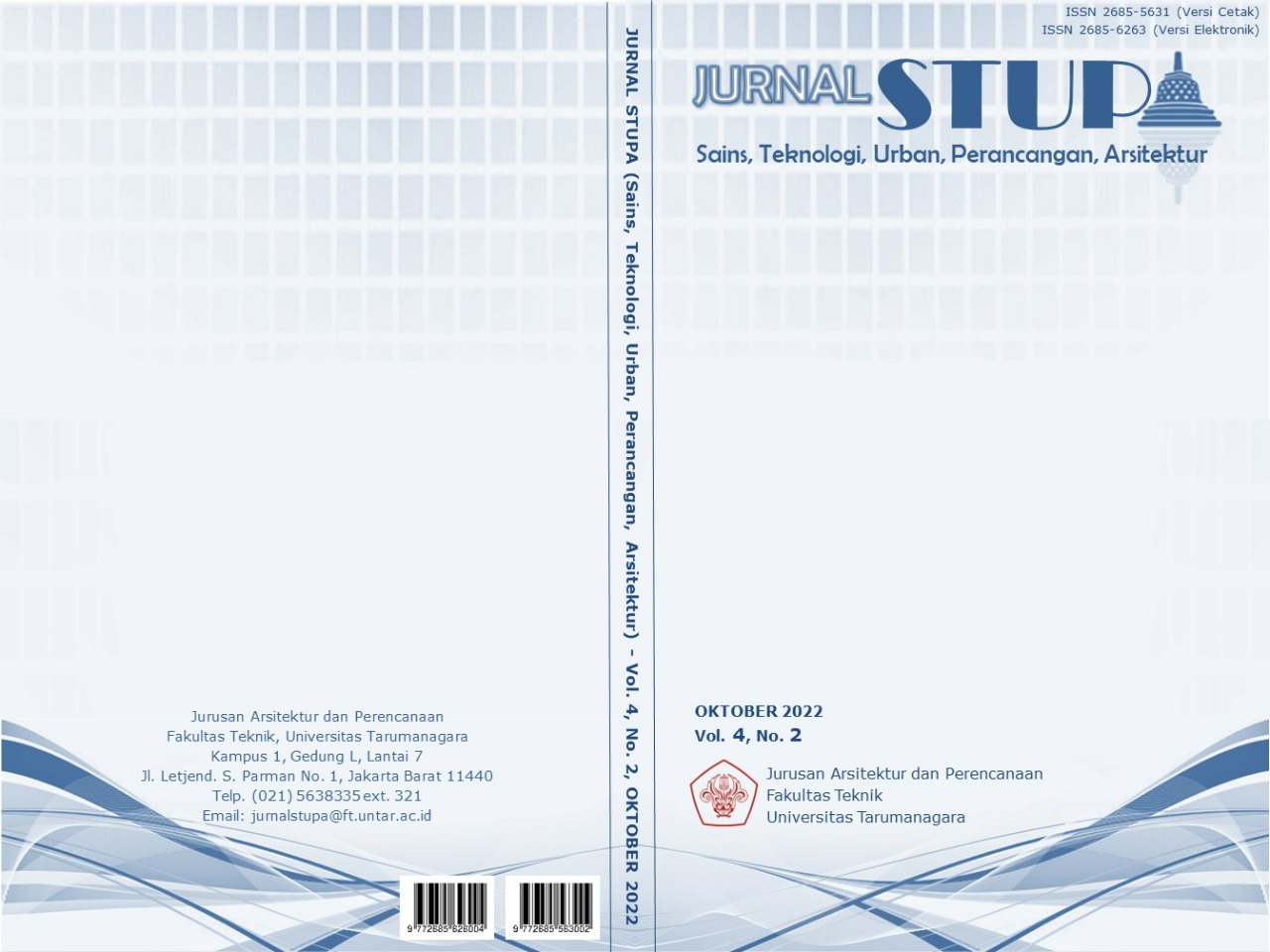STRATEGI PERANCANGAN TEMPAT KETIGA SEBAGAI PEMICU JEJARING PERGERAKAN DAN AKTIVITAS DI JALAN PALATEHAN BLOK M
Main Article Content
Abstract
As a commercial center, Blok M has succeeded in becoming the center of youth trends in the 80-90s. In fact, in 1992, Blok M had the first Underground Commercial and Transit Hub in Indonesia, namely Mal Blok M. Currently, visitors who come to Mal Blok M only pass through to transit to Blok M Terminal, as necessary activities. The role of movement and activity networks in northern and southern underground access certainly needs to be studied in order to maximize movement to Mal Blok M and Blok M Terminal, so that sensitive areas can be identified and a new movement network triggering activity program is created. The research method was carried out through 2 stages. First, observation of the area is carried out either directly, or through e-books, Google Earth, and Youtube videos. This data is then processed using the method of mapping the movement and activity network in the Blok M area. The design method is carried out by combining the principles of urban acupuncture and third place, where the design will focus on forming a movement network node and making the site a meeting point for 3 main activities, namely as a crossing area (necessary activities), a stopover area (optional activities), and a destination area. (social activities). In addition, this design also utilizes the role of communities within the area (workers) and communities outside the area (visitors).The design strategy resulted in 4 main programs. First, Shop and Go as a stopover area targeting workers and visitors who want to go to Blok M Terminal. Second, Community Co-Working Space as a stopover area for workers who want to continue their work for a while before heading to the transit point. Third, Corporate Powered Co-Working Space as a destination area, providing rental space for small industries. Fourth, Roller Skate Space as a destination area for communities with regular exercises and for visitors from other regional magnets.
Keywords: Movement Linkage; Third Place; Urban Acupuncture
Abstrak
Sebagai pusat komersil, Blok M telah berhasil menjadi pusat tren kawula muda pada tahun 80-90’an. Bahkan, pada tahun 1992, Blok M memiliki Commercial and Transit Hub Underground pertama di Indonesia, yaitu Mal Blok M. Saat ini, pengunjung yang datang ke Mal Blok M hanya lewat untuk sekadar transit menuju Terminal Blok M, sebagai necessary activities. Peran jaringan pergerakan dan aktivitas pada akses underground utara dan selatan tentunya perlu ditelaah guna maksimalisasi pergerakan menuju Mal Blok M dan Terminal Blok M, sehingga area sakit dapat teridentifikasi dan diciptakannya program aktivitas pemicu jejaring pergerakan yang baru. Metode penelitian dilakukan melalui 2 tahapan. Pertama, observasi kawasan dilakukan baik secara langsung, maupun melalui e-book, Google Earth, dan video Youtube. Data ini kemudian diolah dengan metode mapping jaringan pergerakan dan aktivitas pada Kawasan Blok M. Metode perancangan dilakukan dengan penggabungan prinsip akupunktur kota dan tempat ketiga, dimana perancangan akan terfokus untuk membentuk simpul jaringan pergerakan dan menjadikan tapak sebagai titik temu 3 aktivitas utama, yaitu sebagai area perlintasan (necessary activities), area persinggahan (optional activities), dan area destinasi (social activities). Selain itu, perancangan ini juga memanfaatkan peran komunitas dalam kawasan (para pekerja) dan komunitas luar kawasan (para pengunjung). Strategi perancangan menghasilkan 4 program utama. Pertama, Shop and Go sebagai area persinggahan dengan target para pekerja dan pengunjung yang ingin menuju Terminal Blok M. Kedua, Community Co-Working Space sebagai area persinggahan bagi para pekerja yang ingin melanjutkan pekerjaan sejenak sebelum menuju titik transit. Ketiga, Corporate Powered Co-Working Space sebagai area destinasi, memberikan ruang sewa bagi industri kecil. Keempat, Roller Skate Space sebagai area destinasi bagi komunitas dengan latihan rutin dan bagi para pengunjung dari magnet kawasan lainnya.
Article Details

This work is licensed under a Creative Commons Attribution-NonCommercial-ShareAlike 4.0 International License.
This work is licensed under a Jurnal Sains, Teknologi, Urban, Perancangan, Arsitektur/ STUPA Creative Commons Attribution-NonCommercial-ShareAlike 4.0 International LicenseReferences
Christella, Werdiningsih, H., & Darmawan, E. (2014). Stasiun MRT Terintegrasi Blok M Jakarta: Penekanan Desain Arsitektur High-Tech. IMAJI Vol. 03 No. 04, 577-585.
Gehl, J. (2011). Life Between Buildings: Using Public Space. Washington: Island Press.
Lerner, J. (2014). Urban Acupuncture: Celebrating Pinpricks of Change that Enrich City Life. Washington: Island Press.
Oldenburg, R. (1989). The Great Good Place: Cafes, Coffee Shops, Bookstores, Bars, Hair Salons, and Other Hangouts at the Heart of a Community. New York: Da Capo Press.
Sutanto, A. (2020). Peta Metode Desain. Jakarta.



